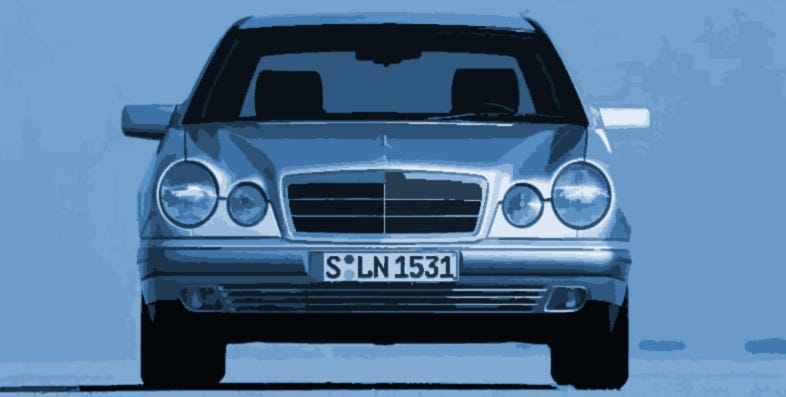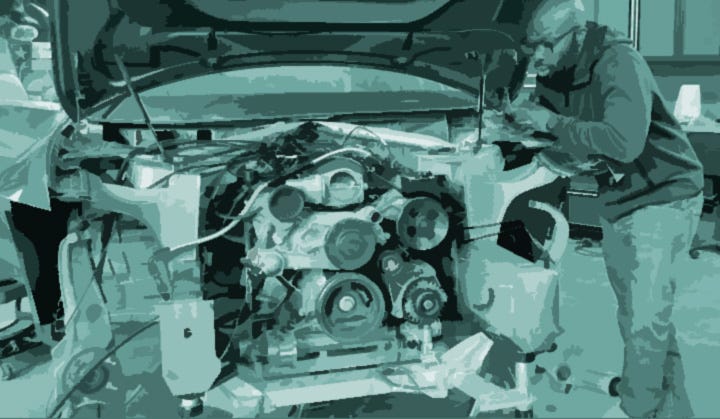September 19, 2023
Somewhere in Interweb land, a guy with a new-ish Ford truck ended up spending $5,600 to fix a burned-out taillight. You read that correctly. The story has been making the rounds via the mechanic who diagnosed and repaired the vehicle. The truck’s owner brought it in because of numerous electronic faults affecting the stereo, the HVAC system, and finally the entire dash. Eventually the $60,000 techno-wonder would not start.
Mechanic Brian Makuloco correctly diagnosed that the truck’s CANBUS wiring system was causing a cascade of computer module failures, originating in the blind spot and cross-traffic monitoring sensor(s). Those happen to be located in the taillight, and failed because of a leaky seal. The seal itself is apparently not a replacement part, but the taillight is $1000. Add up the other five or six computer modules that got fried, plus labor, and the bill came to $5,600. The owner took some advice he got online and submitted it as an insurance claim! But it only covered $5,100.
There is so much wrong with this scenario that I don’t even know where to begin, but it is nothing new. I am a life-long car guy, Readers. My career started briefly in the automotive industry, then transitioned to tools and equipment. You could say I’m acquainted with both the design side and the repair side of things, and stories like this used to make me boiling mad. But now I just expect it.
A common failure mode would be a serpentine belt that runs all the engine accessories, and the water pump. So, a bad air conditioning compressor clutch pulley could snap that belt and render you helpless on the side of the road with an overheated engine. Imagine the idiotic process leading to that decision in the halls of GM when they developed the 3800 V6, which must be one of the most prolific engines of all time. It must not have mattered in the cost / benefit ratio, but it would matter to you if the engine was ruined from warped cylinder heads... all because of a pulley.
The Ford taillight problem is a needlessly integrated complex system. Unlike replaceable bulbs costing $1 from the hardware store, this truck had CANBUS. If you are unfamiliar with the term, just think of a single wire replacing many. Instead of dozens of little wires carrying voltage everywhere, the CANBUS sends signals to different modules on a shared wire. Sounds simple, except now the whole wiring system is interdependent on signals and computer chips. I can’t hate on Ford, though, when everyone is doing it. Appliances, computers, you know the tale. Over time, entire industries have moved in this same direction, creating a situation where the owner either has no idea how to fix it, or lacks the tools to fix it, or the parts are not even available.
The Right to Repair
This whole topic is known as Right to Repair, and I bring it up today because it will directly impact your ability to be self-sufficient during the coming dark days. These problems have become so commonplace that we think of them as normal. “Boy, I wish things were still simple.” Allow me to briefly rant, so you get what I mean:
- Those weird little screws on the back of your laptop that cannot be removed without buying a specialty set of drivers.
- That washing machine belt that costs $250 from the manufacturer, and the gear oil that costs $50, when both could be sourced from Autozone for about $20.
- Bespoke specialty parts that can only be ordered from the manufacturer, which could have been a common design but are not. Brake piston seals for my Toyota have to come from Toyota or they will not fit.
- Parts they won’t sell you because you are not an authorized repair center.
- Tools, computers, and appliances that have slight differences from one store chain to the next, so that they carry different model numbers; and thus, different warranty and repair policies.
Louis Rossman is a name you might recognize if you own an Apple product. He has become a champion of the people in this fight for the Right to Repair. He made his living and gained a huge following by showcasing repairs on common failures for Apple / Mac computers. With the right tools and techniques, you could make the same repairs he did. Louis noticed over time that Apple was throwing up roadblocks to independent repair shops, such as making certain components impossible to source. He saw simple design flaws that would often result in the machine being too expensive to fix, for example a resistor that would render the video driver inoperable (black screen). The recommended fix was always send it in to the Apple store and we will replace the screen. For a $1 resistor.
I corresponded with Mr. Rossman a few years back on repairing a bad motherboard I have, and he quickly concluded it is not even worth the shipping hassles to send it internationally to his shop. He’s about as straight as they come in my book. Shipping and supply chains are an additional dimension, especially for those of us outside of the normal shipping routes. Right to Repair encompasses supply, logistics, regulation, even information. Try getting a circuit schematic from Apple, for example.
Louis has been in front of Congress on these matters, and many of the talk shows. He is serious because it directly affects his livelihood. But he is a threat to these companies, because the implication is that manufacturers and suppliers must be doing this by design to make products unrepairable. You’ve already seen this in the way software updates cause your older phone to get hot and slow down. It has been shown that this is nothing more than a tactic to encourage you to upgrade. There are many valid points being made, and even some legislative wins.
Expensive, throwaway products are the antithesis of liberty and freedom. You probably all have rants similar to mine, but start to extrapolate it forward... Cars would become impossible to own, driving everyone into factory-supported leasing options. The habit of keeping older devices or appliances around could end completely; all the manufacturer has to do is make the OS upgrade incompatible with the old hardware. Even factory repairs we could expect to go away, in favor of something like a trade-in scheme. They already have this in place with the phones -- upgrade it every year on your calling plan. Like the Mafia killer says in the movies as he spins a silencer onto his pistol, hey buddy, it’s just business.
At my first professional job in Detroit, mid-‘90s, we had a ‘tear-down room’ wherein was parked a brand-new Mercedes E-Class. That is the W210 for you car guys, and it had just been introduced. The technicians who were taking it completely apart, shockingly, thought it was a piece of junk. “Yep, the ‘80s Mercs were the last ones built to a standard”, one of them told me, “the new ones are just built to a price”.
The same observation has held up through other jobs and dozens of consulting projects over an almost 30-year career. Products are built to a price point. Business models insist on it, so test labs find out exactly how a design will perform, and the engineering team makes sure it lasts just long enough for the warranty. They go round and round to dial this in closely, to create maximum profit. Oh, they could over-design it to be tougher, but that is not the spec. Maximum durability is a rarity in business decisions, and increasingly, that means less and less repairability.
It is no wonder that the biggest trend in new cars are those subscription options everyone seems to hate. Gotta squeeze every last cent out of the profit model, while simultaneously making things impossible to diagnose and fix. But let’s shift gears and talk about how to turn the tables.
Wanted: Old School Mechanics
I have seen the possible future, and it looks like Cuba. Maybe you can see a day coming, Reader, where three-year-old cars just sit in the weeds for lack of a computer chip. Or that Nissan won’t run without six new coil packs, even though only one is bad. But good old mechanical know-how cannot be defeated so easily, once we are willing to look beyond that State’s regulatory powers. Even a modern car can be reclaimed by determined individuals.
Firstly, if you are not doing this already, it would behoove us normal consumers to think on the repairability of something before we buy it. Where I live now, those decisions are based on what stores are nearby; like if I have to go to the city it is a 5-hour drive.
Second, there are a few products that buck the trend and are designed for repairability. The laptop brand Framework comes to mind. In general, older products will be more readily repairable if you don’t need to have the latest thing. When I bought an older Blackberry phone, I bought two of them so I’d have spare parts. They disassemble easily. This works for cars too; get an extra parts car if it is cheap.
Third, it often pays to invest on the front end for the specialty tools needed for a job. Over time you accumulate these things and feel less helpless when something fails. Laptop disassembly is not a problem any longer at our house.
Fourth, look to the aftermarket industry, which often has solutions already available. Ways to bypass, or circumvent, or improve problem areas. Brake systems, air conditioning, even standalone engine management. Of course some things may be for ‘racing applications’ (wink, wink).
Finally, be inspired by some of the repairs you can see online from places like Pakistan. The ones where they disassemble and rebuild a 24V truck battery are uncanny. Or how about re-molding a truck tire by hand. There are tons and tons of DIY ideas out there, it is one of the things YouTube is great for, even though I complain about the internet in general.
Living in the Philippines has given me a completely different perspective on things like repairs and recycling. I have just about seen it all, and sometimes you just have to look the other way. We don’t throw out much of anything, because you never know when you might need to make a rubber bushing out of an old tire, or adapt parts from different vehicles onto yours. It’s a bit like Mad Max sometimes, but on a more practical level.
We have a whole class of vehicle here called the Owner-Type-Jeep. This is essentially a hand-made, stainless steel copy of an old Willys Jeep, outfitted with an engine and axles from whatever you can find. These are about as rudimentary as an old tractor, but are somehow able to be registered and driven. There are plenty of fire trails and off-pavement routes in the outback of America where a home-brew vehicle could operate, and if SHTF I doubt you will really care about the inspection sticker on the windshield.
This is a shift in the way people think though, and I recognize it is not easy for most. But I have a sneaking suspicion that old-school mechanics are going to be in high demand under such a scenario. Maybe sooner than we think. Imagine just ripping out the wiring harness in that $60K F-150 and replacing everything, with toggle switches in the dash. That is how they would do it here where I live, and boy would it feel liberating.
In closing, right on time for this essay I just read that Tesla is looking to create the entire chassis of one of their cars as a single aluminum casting. Article and interesting comments here. It would be incredibly difficult to make, easy to crack, and unrepairable most likely. But it would replace 400 parts, and so they are seriously evaluating the idea. Can anything be more insane? But we live in Bizarro-World, where it seems entire cars are just throwaway items. I guess they will dump old Teslas in one end of the factory, and new ones will spit out the other end. Maybe they’ll lease you one if your social credit score is high enough.
But not for this DIY Tesla guy below, to leave you on a high note. He is transplanting a V8 into his Tesla. Now that is some American spirit.
We’re going to beat these guys yet, Readers, I can just feel it. So get out in that garage and roll your sleeves up, because they may tear this whole place down before it is all over. Lots of stuff to fix and modify. Invest in tools and skills.
Peace be upon you in Christ, friends,
Visayas Outpost






A delightfully positive note from VO in the South. You know I am a petrol-head, all my life into cars, bikes and trucks. But here I drive a 1999 Toyota, built during that companies' so-called 'Golden Age' when huge amounts were spent on quality control, and even now in 2023 everything works as it should. The closest it gets to 'electronic interference' is Fuel Injection, but I posit that is essential in an age of ethanol additives in fuels. My phone is c.2010 and is made of metal. My motorcycle does not sport any ridiculously unnecessary add-ons like drift control, abs, launch or FST screens. It is easy to maintain and dependable, as well as being more frugal than the meanest man I know.
Recently, the UK MoD ordered a batch of Land-Rover Defenders for the military and specified that all electronic aids be removed. Vehicles like motorcycles and military equipment get wet, very wet. And you know what happens to electronics when wet. Just ask the owner of the F150 at the top of your story! Or ask any owner of a top-of-the-line Mercedes that is over, say, 6 or 7 years old. The cost of maintenance is so high due to electronic failures these $150,000 mega cars go for peanuts when a few years old.
Finally, a chum here has a Ford Ranger pick-up and he has spent a small fortune on electronics repairs and is now actively looking for a car like mine, or better still a Nissan Patrol as the old model Y61 is still made for the UN and some miltaries. Drive happy VO.
Only a real DIY guy or gal will appreciate that last picture. To me it ay F you globalists, I'm doing it my way.
I was just telling the girlfriend, "I need to find a younger vehicle, that is just below the tech threshold (so as few chips as possible). I have a 2005 Xterra, with 200K+ that just made a 13 hour (1000 mile) trip and will make the return trip in a month or so. I do all the work on it and know every issue it has - only two.
I had a 2003 Audi Allroad, which was a great car, when it ran. However, it suffered from the same problem as the Ford...integrated systems and circuitry. One code related to no less than 6 components. Finally had to let it go.
You are correct about the societal shift to accepted obsolescence and disposability.
I had a friend who's wife told him they needed to buy another car, because the side view mirror was broken. While this used to be a funny anecdote, it is reality, where the newer masses are concerned.
In the future, those "sophisticated and enlightened" Western countries would do well to take lessons from your corner of the world, but they won't.
Imagine a civilization that has been taught to take pride in a shiny, name brand, popular thing, that does not work...verses a dull, mundane and pedestrian thing that does.
Good post!